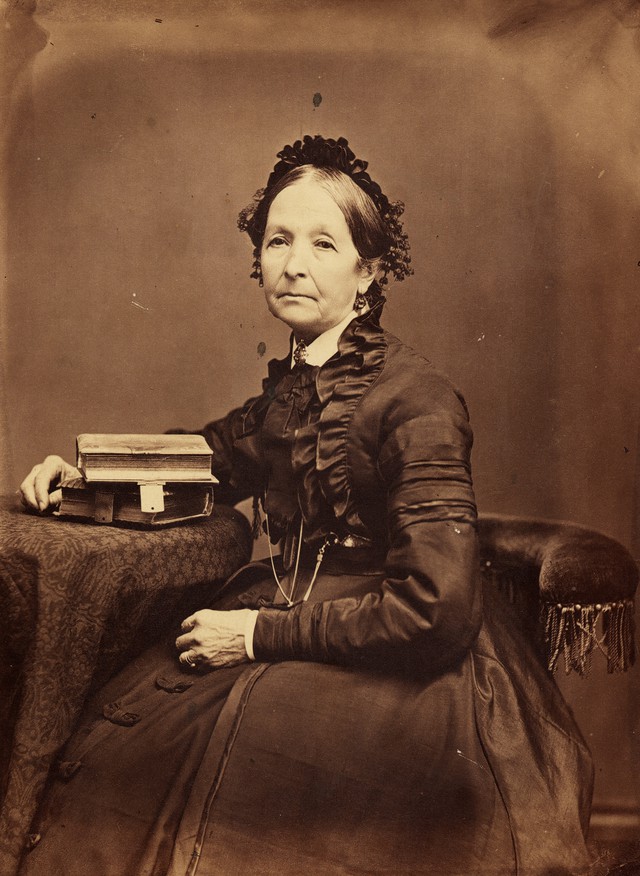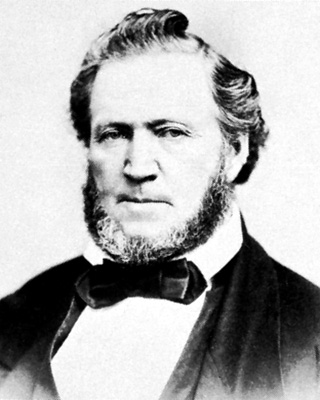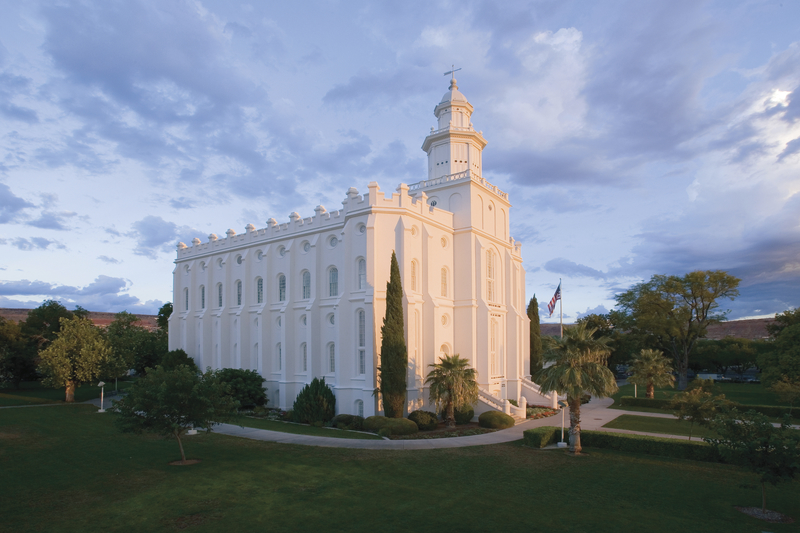When I sat down to casually read something from the April 2021 Journal of Mormon History, I expected to find something interesting (because, clearly, I am very cool). I did not expect to have one of those rare moments as a reader when I suddenly felt seen and understood. I was given words to describe something for which language had evaded me for years.
The article was, “‘I Would Not Risk my Salvation to Any Man’: Eliza R. Snow’s Challenge To Salvific Coverture,” by Brooke R. LeFevre, a history master’s student at Utah State University. LeFevre worked at the Church History Library on the new Discourses of Eliza R. Snow, and I was pleased to see an article emerging from this project. But as I came to understand the meaning of “salvific coverture”—a term that LeFevre coins and defines—I realized that this article was going to be personally important to me.
As LeFevre explains in the article, “salvific coverture” has two main parts. “Salvific” means something that leads to salvation, and “coverture” refers to the common law practice in which the legal existence of a married woman is suspended and consolidated into that of her husband. Under coverture, women do not have individual rights or legal standing upon which to enter contracts, own property, vote, etc. Their rights are under the protection or “cover” of their husbands. And thus “salvific coverture” refers to “the tendency within Mormonism to believe that female salvation came through the husband to whom she was sealed, that husbands were salvifically responsible for their wife or wives, and/or that a woman could rely on her husband for salvation.”[1]
The focus of the article is how salvific coverture functioned in the public teachings of Brigham Young and his contemporaries, and how Eliza R. Snow challenged these teachings in favor of women taking individual responsibility for their own salvation. While Brigham Young taught, “Let our wives be the weaker vessels, and the men be men, and show the women by their superior ability that God gives husbands wisdom and ability to lead their wives into his presence,”[2] Eliza wasn’t having it.

Eliza, temple High Priestess and acting General Relief Society President, travelled throughout the Utah Territory speaking to women to train them in the female auxiliaries. She was not a modern feminist, and she regularly deferred to male priesthood leaders, but she did not believe that women could defer to their husbands in the matter of salvation. For example, she said, “Remember, you have to work out your own salvation: neither father, brother, or husband can do it for you. Your eternal existence depends on how you spend your life.”[3]
If you have access to the Journal of Mormon History through a personal subscription or via a university or local library, the entire article is worth a read. To be clear, LeFevre’s argument is limited to public discourse related to salvific coverture by nineteenth century Mormon leaders—she does not detail how it plays out in temple liturgy. But from a personal standpoint, I could see the way that salvific coverture has lingered in Mormon theology and temple practice.
It is hard to overstate the cognitive dissonance I experienced going through the temple in 2008. It was the first time I noticed salvific coverture in Mormon theology. I didn’t have a term to describe what I saw, but it seemed clear that in the Endowment, the Atonement of Jesus Christ was presented as functioning differently for women than for men. After Eve and Adam partake of the fruit and are informed of their consequences, Elohim explains that because Eve partook of the fruit first, she must obey the Law of the Lord and harken unto Adam’s counsel, as Adam must harken unto Elohim and obey the law of Elohim; a Savior would be provided that he [Adam] may return to the presence of God. Eve then covenants to Adam, while Adam covenants to Elohim. Eve does not make covenants with Elohim directly. Her salvation is presented as coming through her obedience to Adam—her husband.
As a twenty-year-old going through the temple for the first time days before my wedding, I was blindsided by this theology. I had understood Jesus Christ to be my personal Savior, and it was disorienting to be instructed that women (whether married or not) covenanted to their husbands instead of God. It was contrary to what I believed about my Heavenly Parents and my relationship to them.
In January 2019, the temple ordinances underwent significant changes that removed much of the overtly sexist language and actions. Now, Eve covenants directly to Elohim, but just as the Ghost of Eternal Polygamy haunts the temple, the concept of salvific coverture lingers on. While previously Eve was anointed to become a queen and priestess unto her husband, she is now anointed to become a queen and priestess in the New and Everlasting Covenant. After spending some time reading D&C 132, I’m not convinced that this is a theological improvement for women. It is still not an equal promise as men are anointed to become kings and priests directly unto God.
For years, I struggled to find anyone who would talk with me about this theology. When I reached out to active, temple-attending members, I would generally be shut down or shamed for finding anything in the temple problematic. I felt gaslit and alone.

As I studied more of Mormon history, particularly the teachings of Brigham Young and his male contemporaries, I found that I was not misinterpreting the temple ceremony—I was identifying an oft-repeated belief of these men. While some suggest that biological sex in the temple is only symbolic, I can’t accept that interpretation when the theology surrounding biological sex also matches the public teachings of 19th century Mormon patriarchs.
The problem is not academic. There are real-life consequences in Church structure and family dynamics from a theology that holds up heterosexual, married men as the saviors to their wives and children. Bad theology hurts people. It hurts all of us, but especially the marginalized who are left out of the proposed order of heaven altogether.

LeFevre’s work naming this theology and contextualizing it in framework of legal coverture is helpful in understanding the particular culture of the men who wrote the temple ceremonies. I knew that while the Endowment was introduced by Joseph Smith in Nauvoo in 1842, it was not written down and standardized until Brigham Young directed an all-male committee to do so in 1877 upon the completion of the St. George Temple.[4] I did not realize, however, that even as these men secured their belief of salvific coverture into the ceremony for generations to come, there was an alternative theology being widely preached by Eliza R. Snow.
I can’t help but wonder what the results could have been if Eliza was included in the committee to write the temple ceremonies. Would she have prevailed with her belief that men and women worked out their salvation individually before God? What if the committee was equally composed of men and women?
And today, what if we fully abandoned the notion of salvific coverture and leaned into the idea that all individuals—men, women, nonbinary, and gender minorities—stand before God, every individual dependent upon the Atonement of Jesus Christ for Salvation? If human men were no longer burdened with their entire family’s salvation, would they feel renewed in Christ? Would women better trust in Christ and their own strength? Would this make room for real partnership among all genders? If heteronormativity was not presented as the only way to salvation, could we openly embrace our queer siblings? Could the Church treat unmarried adults as being whole, complete, and loved by God exactly as they are?
The ramifications of removing the vestiges of salvific coverture and really trusting Jesus Christ to be the Savior could be transformative. Healing. I hope for such a time. But in the meantime, I’m resting a little easier in my own mind, no longer searching for the language to describe a concept that I could see but not name. It is such a gift to have new language to discuss outdated theologies.
[1] Brooke R. LeFevre, “’I Would Not Risk My Salvation to Any Man:’ Eliza R. Snow’s Challenge to Salvific Coverture,” Journal of Mormon History 47, No. 2 (April 2021), 52.
[2] Brigham Young, June 15, 1862, Journal of Discourses, 26 vols. (London: LDS Booksellers Depot, 1854-86), 9:308, cited in LeFevre, 58.
[3] Weber Stake Young Women’s Mutual Improvement Association, September 9, 1881, LR 9970 17, cited in LeFevre, 64.
[4] Devrey S. Anderson, The Development of LDS Temple Worship 1846-2000: A Documentary History (Salt Lake City, UT: Signature Books, 2011), xxxi.






21 Responses
Katie, this is excellent. I felt betrayed by the temple when I went through in 2000. Taking part in that ceremony and thinking of the implications was probably the most painful experience of my life. Thanks to you and LeFevre for giving us language and context to identify what was/is going on in these rituals. It’s a real shame church leaders couldn’t have fully removed women’s subordination/salvific coverture from the temple as they were doing the recent overhaul.
Thank you, Caroline. I agree–the 2019 overhaul was a missed opportunity to fully root out this theology.
Yes to all of this!
Thank you!
Thanks, Katie. And thanks to Brooke.
Thank you for reading!
> “While previously Eve was anointed to become a queen and priestess unto her husband, she is now anointed to become a queen and priestess in the New and Everlasting Covenant. After spending some time reading D&C 132, I’m not convinced that this is a theological improvement for women.”
I was not familiar with the new language. This specific change looks like choosing to make what is acknowledged as a source of distress more opaque and implicit rather than wrestling with the distress. Managing people’s feelings without addressing their concerns might accurately be called patronizing.
To be more generous, one could say that the church does believe in salvific coverture for *both* men and women. It’s certainly very clear that singleness is second-class in LDS society and theology of the eternities. I think many church leaders truly believe in this, and hetero-cooperative necessity for exaltation is behind a number of church positions like continuing opposition to gay marriage.
But that doesn’t address the question of why the specific covenants are gendered and patriarchal in presentation. Noting history involved formalization by all-male 19th-century committees selected by leaders fully subscribed to literally patriarchal views does have a lot of explaining power.
“Managing people’s feelings without addressing their concerns” – yes, this. I was glad for so many of the changes, but there were moments that seemed to manage feelings without addressing harmful theology or seemed explicitly targeted to exclude LGBQ individuals.
The “New and Everlasting Covenant” was polygamy. So, where before women were queens and priestesses to their husbands (and it could be monogamous) now it is dependent directly on polygamy. It now requires our husband to have more than one wife. I think this is a step backwards. Of course, now the church tries to pass off the New and Everlasting Covenant as eternal marriage, but it originally meant plural wives, specifically not monogamy. The church is just finding new ways to say the same old sexist stuff. It’s called gas lighting.
And the ceremony at the veil is also gender specific. A woman’s husband acts as her “lord” and brings her through the veil, so the ceremony still acts out the idea that women depends on their husband to get into the CK. Sure the church says a man must be married, but he is already in the CK when he brings his wife through the veil. So, the wife still depends on her husband to get into the CK, while the requirement for a man is that he be married, it is not his wife who brings him into the CK, but The Lord. Where with a woman it is “her lord.” Same word, but one is capitalized because it is God, the other is lower case because it is just a husband. It is still anything but equal.
Yes – exactly this!
“The Lord” vs “her lord” is precisely the issue at hand. Thank you for pointing this out.
Wow, this explains a LOT of my discomfort with church doctrine. Enlightening!
I’m glad you found it enlightening. Getting the language from Brooke LeFevre’s article was so meaningful to me.
Thanks so much for highlighting this language!
It is interesting to note that although Eliza was a plural wife of both Joseph Smith and Brigham Young, she never changed her name, and thus on purpose did not allow herself to be absorbed or covertured by either of them, even though both were powerful prophets.
I do believe she thought women should work out their own salvation, and that indeed, the restoration was largely a restoration of female power. She kept the Relief Society minutes where Joseph testified of female authority, and she was heavily consulted in the book the Women of Mormondom, which, published in 1870’s pioneer Utah, is a fascinating alternative female-centric interpretation of the gospel that, in my opinion, reflects her influence enormously.
She did defer to priesthood power – almost painfully at times – but in my opinion it was in word only and an act of political astuteness. She could say almost anything she wanted and be pretty spectactularly bold if she just added “….under the prophets” at the end. I recall once she gave a crazy discourse on how resurrection worked (printed in the WOmen’s Exponent). She was allowed to have so much power because she was part of Brigham’s claim to authority coming to him through Joseph, as opposed to going to his own Son through Emma. This made sense, since Brigham and Emma hated each other and fought bitterly after the martyrdom. But Eliza accepted the charge – under the prophets – so Brigham would re-enstate the Relief Society (that he dissolved in Nauvoo) and allow her to lead the women of the Church in Utah. After Eliza, female power in the church shrank immensely. She was able to keep alive a langauge of Queens in Heaven and Prophetesses and Priestesses, but not after her demise. Although recognized as the High Priestess, she was too powerful for Brigham to let her anywhere near the endowment language. I hope a high priestess will one day be consulted on female salvation and set things to rights in the temple.
I wrote this awhile ago, trying to work out the mystery of the “priestesses” mentioned in the temple, and you may like it too:
http://www.feministmormonhousewives.org/2014/04/the-mormon-priestess-the-short-version/
Hi Elizabeth! I read the long version of your essay, possibly back in 2015, and the version included in the anthology Mormon Feminism. It is such an important essay to this discourse and to me personally. I was already over the recommended word limit for blog posts here, but if I were to extend this into a longer essay and bring in more works that have influenced my thinking and helped me feel seen, yours would have been high on my list. Thank you for reading and commenting.
Thank you Katie and Brooke! And Eliza! I agree, these kinds of biases and blind spots, passed on for generations through ceremonies and scripture, will only continue until we allow more diverse perspectives, including female perspectives, to mold our theology.
Brooke LeFevre on the So You Want to Talk about Mormonism podcast discussing her article: https://open.spotify.com/episode/4uYLHqZkYiYCouilmjTLo2
[…] and has been challenged since at least the 1870s. However, I see the concept still showing up in modern LDS temple practice, and again in Renlund’s suggestion that seeking Heavenly Mother amounts to speculation with […]
Katie, are you familiar with the Hurrians? Abraham was a member of that society and there was a curious custom in Hurrian marriages. Before the marriage the man had an opportunity to give his future wife, a Sisterhood document, declaring her to be his sister before she became his wife. This also sheds some light on why Abraham introduced Sarah as his sister to both the Egyptian Pharaoh and to Abimalech, King of Gerar. The document itself acknowledged the future wife to be the man’s equal in all things under the laws of that society, with the right to hold property in her own name and so forth. That society only lasted for about 100 years but its affects on the Patriarchs: Abraham, Issac and Jacob can be readily seen in Genesis.
When Sarah was displeased with Hagar’s conduct over the business of begetting Ishmael and went to Abraham about the matter, he reminded her that Hagar was Sarah’s maid (given to her by pharaoh), not his, and that Sarah was free to do with her as she saw fit. That makes it sound very much like Abraham had indeed given Sarah such a document. The behaviour supports that idea.
Since Abraham, Issac and Jacob and their wives are cited as the examples/models upon which Latter-day Saints should base our understanding of marriage and family, I believe this is relevant to your concept of “salvific coverture”. The idea extends even further since members of the Church of Jesus Christ of Latter-day Saints are strongly encouraged to select spouses from among members of that church. In other words, they are encouraged to marry ‘a sister’ and as a sister she would have all the same rights as the man she is marrying!
Too many of the modern ideas of marriage come from the customs of the societies in which we live which are mostly patriarchal in origin and not well aligned with ideas about marriage from the scriptures. I do not believe that many of those customs are in harmony with what Latter-day Saint marriages should be. Utah, in particular, has a real problem with how they treat women. In the 2017 Gender Pay gap research done in the US by the AAUW, Utah has one of the lowest pay rates for women as compared to men, around 70% of the pay for a man. Just one example.
[…] the message to women and girls that they are inessential, that they are afterthoughts, that their personhood is subsumed under whatever male they happen to be attached […]
[…] [3] https://www.the-exponent.com/new-language-for-outdated-theology-salvific-coverture-and-modern-lds-te… […]